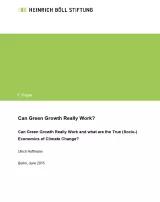Can Green Growth Really Work?
Abstract
Many economists and policy makers advocate a fundamental shift towards "green growth" as the new, qualitatively-different growth paradigm, largely based on enhanced material/resource/energy efficiency, structural changes towards a service-dominated economy and a switch in the energy mix favouring renewable forms of energy.
"Green growth" may work well in creating new growth impulses with reduced environmental load and facilitating related technological and structural change. But can it also mitigate climate change at the required scale (i.e. significant, absolute and permanent decline of greenhouse gas (GHG) emissions at global level) and pace (i.e. in no more than two decades)?
This paper argues that growth, technological, population-expansion and governance constraints as well as some key systemic issues cast a very long shadow on the "green growth" hopes. One should not deceive oneself into believing that such an evolutionary (and often reductionist) approach will be sufficient to cope with the complexities of climate change. It may rather give much false hope and excuses to do nothing really fundamental that should bring about a U-turn of global GHG emissions. The proponents of a resource efficiency revolution, re-structuring of economies and a drastic change in the energy mix need to scrutinize the historical evidence, in particular the arithmetic of economic and population growth. Furthermore, they need to realize that the required transformation goes far beyond innovation and structural changes to include better distribution of income and wealth, limitation of market power of economic agents that promote biased approaches to GHG reduction, and a culture of sufficiency.
Climate change calls into question the global equality of opportunity for prosperity (i.e. ecological justice and development space) and is thus a huge developmental challenge for all countries, but particularly for the global South and a question of life and death for some developing countries. The author would like to extend particular thanks to Frank Grothaus, Detlef Kotte, Jörg Mayer, Chandran Nair and Gunnar Rundgren for their helpful comments for improving the manuscript.
Ulrich Hoffmann
Geneva, June 2015
Product details
Table of contents
- The Author
- Abstract
- Introduction
- Limits set by the arithmetic of economic and population growth
- The asymmetry between carbon intensity, scale and structural effect of economic growth
- Increasing the use of renewable energy – easier said than done
- The efficiency illusion - the rebound effect
- Linear thinking and horizontal shifting
- Governance and market constraints
- Changing consumption patterns - a hard nut to crack
- Systemic limits – the economic growth fetishism
- The mammoth challenge: how can we extricate ourselves from the economic growth predicament?
- Appendix
- List of references
- Legal Notice
